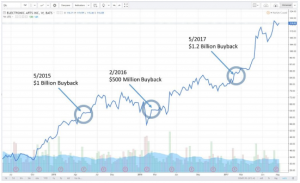It was a scene no odds maker could have put together – Warren Buffett and Floyd ‘Money’ Mayweather.
It seems Warren had just joined the ‘Money Team’ and mouths around the world are still dropped.
Seems the Money Team got more paper – to the tune of $40 billion.
Curiously, Mr. Buffett didn’t include any pictures of his new Money Team partners in his annual letter to investors – or pictures of him and his posse throwing cash in the air in a club.
But the ‘Oracle of Omaha’ did include an important strategy that many traders and investors overlook on a daily basis – stock repurchase programs.
When a stock buyback, or repurchase, takes place – it’s an excellent opportunity to scout for a bargain – both for short and long-term positions. You just need to know what to look for, and what exactly the real value is to shareholders.
Stock buybacks: A complete waste or just plain smart?
Just as the Money Team members have found occasional controversy, so have stock repurchase programs. Some see these simply as a way to enrich management teams that are already over-compensated through stock options.
Buffett took this head on: ‘As the subject of repurchases has come to boil, some people have come close to calling them un-American – characterizing them as corporate misdeeds that divert funds needed for productive endeavors. That simply isn’t the case…’
Under the right circumstances, everyone can win. Sure, the executives in the company are rewarded when the buyback pushes up share price, but shareholders also win, when the stock is undervalued when it’s bought back.
The key lies in understanding the exact impact on share price, and the possible consequences the repurchase can have.
Keep a close eye on value and prior price
Floyd’s stock immediately went up the second pictures surfaced with him and Buffett. His boxing fortune and antics outside the ring were momentarily forgotten. It seems the Money Team has reach and sophistication no one on Wall Street would have ever given them credit for.
The same effect can set in on share price during a buyback. The simple reason: demand. The number of shares held by the public decreases, and the remaining shareholders win – without having to lift a finger.
One important detail, however: If the company pays too much to buy the stock back – or too much of a premium – there’s less cash floating around. Bad enough if you’re on the Money Team. Even worse if you’re an executive trying to reinvest in the company’s future, or a shareholder hoping to cash in on upcoming results.
A profit train that blows its whistle if you’re watching
Floyd Mayweather earned $300 million over 30 some fights, and $150 million in one. As his demand went up, so did his value and earning power. The same is true with a stock repurchase program.
Here’s an example: Earlier this year, Electronic Arts (NASDAQ: EA) announced a $1.2 billion stock repurchase program. This was in addition to another $500 million program last year, and another $1 billion stock repurchase program announced the year before. So, $2.7 billion set aside to take shares off the table. How did the remaining investors do?

One share repurchase leads to another – and investors win along the way.
At the close of 2015, the stock was up 46% at $68.72. At the close of 2016, up another 14%. Year to date in 2017? Another 32% as shares ride right around $116…
Building a winning portfolio with repurchase programs
Like a Money Team release or a Floyd Mayweather fight – you might not be a fan – but you want to know when these events take place. Stock repurchase programs are the same.
Companies that conduct this exercise at a decent price often end up pulling off a win for shareholders in the long run. As a result, you should add these moments to your screening portfolio.
When a repurchase program is announced, compare the disclosed price with the current forecasts. Check to see what the sustained cash flow will be after complete and if there are future repurchases planned (many times these take place in stages).
As you evaluate, know that you have any number of trading strategies at your disposal in addition to an outright buy. If EA is any indication, long-term call options could be a great way to take a position at a fraction of the cost. Likewise, a naked put could be a great way to invest if you’re assigned on a pullback – essentially paying yourself to build your portfolio.
Say what you like about boxing, Mayweather or repurchase programs – they’re a great opportunity for investors.
